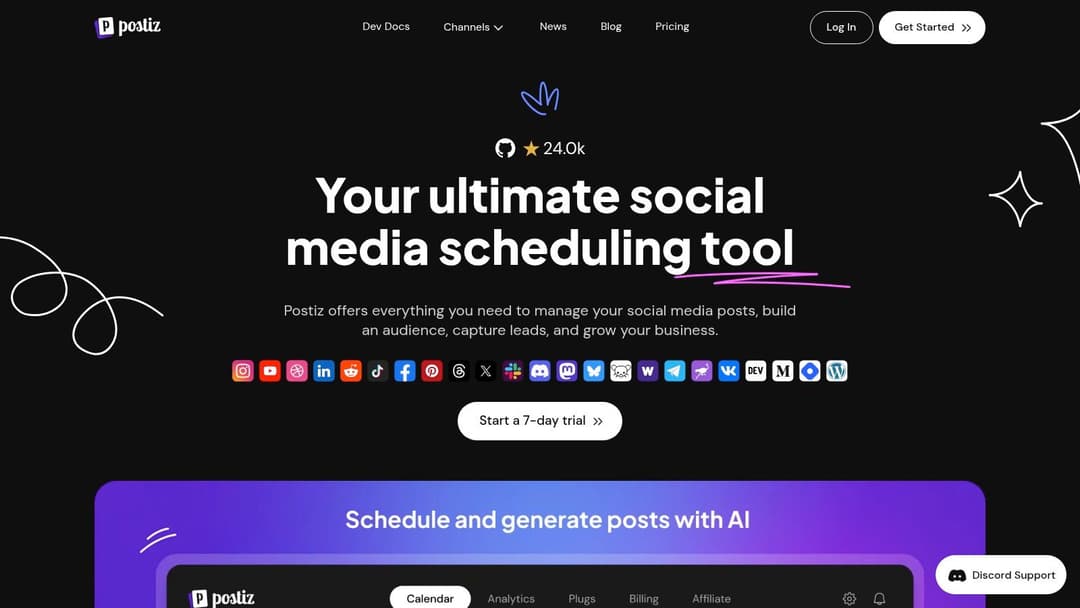In a world of proprietary software and expensive subscriptions, finding powerful and flexible automation solutions can be a challenge. Manually handling repetitive tasks, from deploying code to managing social media or orchestrating complex data pipelines, consumes valuable time and introduces the risk of human error. This is where the power of community-driven development comes into play. The right tools can streamline your workflows, increase efficiency, and give you complete control over your processes without the hefty price tag.
This guide is designed to help you navigate the expansive ecosystem of open source automation tools. We've compiled a comprehensive list of the best platforms available, moving beyond simple descriptions to provide in-depth analysis. Our goal is to equip you with the practical information needed to make an informed decision for your specific needs, whether you're a developer, a small business owner, or a home automation enthusiast.
Inside this resource, you will find:
- Detailed Overviews: We break down what each tool does best, its core philosophy, and its ideal user.
- Practical Use Cases: Discover real-world scenarios where these tools excel, from CI/CD pipelines with Jenkins to visual workflow building with n8n.
- Honest Pros and Cons: Get a balanced view of each platform's strengths and limitations, including potential implementation hurdles.
- Feature Spotlights: We highlight key features that set each tool apart from the competition.
Each entry includes direct links and screenshots to give you a clear look at the software in action. This list is your starting point for reclaiming your time and building more efficient, reliable systems. Let's dive in and find the perfect open source automation tool for your next project.
1. Postiz
Postiz stands out as a powerful, all-in-one social media management solution, positioning itself as a top-tier choice among open-source automation tools. It consolidates the entire social media workflow-from AI-powered content creation to scheduling and analytics-into a single, cohesive platform. This unified approach eliminates the need for multiple disparate applications, saving significant time and reducing subscription costs.
Its core strength lies in its dual nature as both a user-friendly SaaS and a self-hostable open-source project. This flexibility makes it an ideal fit for a wide range of users, from solo creators to digital agencies and privacy-conscious organizations that require complete control over their data. The platform’s robust automation capabilities, combined with an intuitive interface, streamline complex marketing tasks without a steep learning curve.
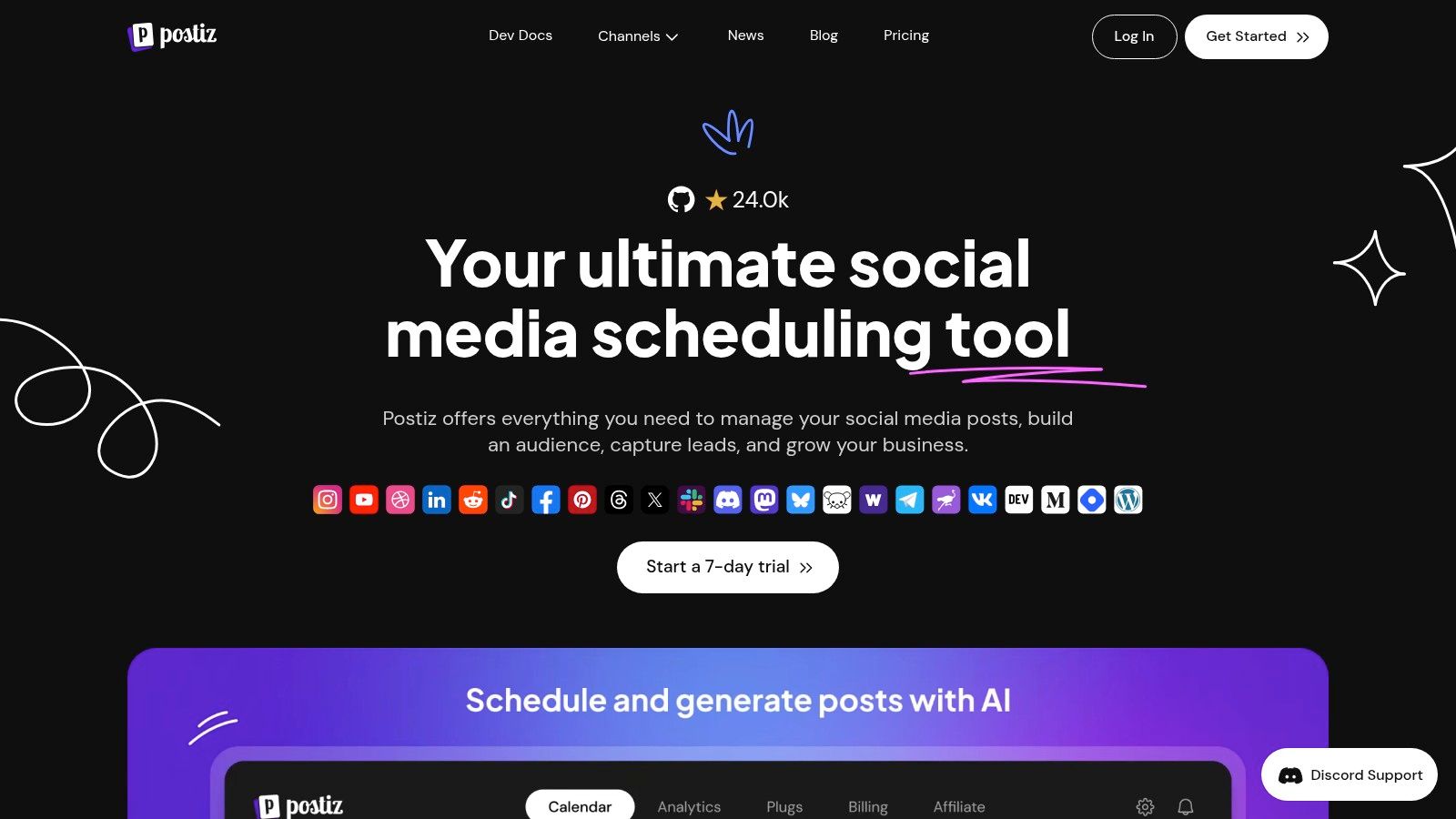
Key Features and Use Cases
Postiz is packed with features designed for efficiency and impact. The AI content ideation and image generation tools are particularly noteworthy, allowing users to overcome creative blocks and produce visually appealing posts quickly. The integrated Canva-style editor further simplifies the design process, making professional-grade graphics accessible to everyone.
For teams, the platform offers advanced collaboration features, including user roles, task assignments, and approval workflows. This ensures that all content is on-brand and vetted before being published across numerous social networks simultaneously.
Practical Applications:
- Agencies: Manage multiple client accounts from a single dashboard, assigning specific roles to team members and generating consolidated performance reports.
- Small Businesses: Use the AI assistant to create a month's worth of content ideas and schedule posts across all channels in a single afternoon, freeing up time for core business activities.
- Privacy-Focused Teams: Deploy Postiz on a private server to maintain full ownership and control over sensitive marketing data and user information.
What Makes Postiz Unique?
The combination of being open-source and offering a comprehensive feature set is Postiz's primary differentiator. While many tools provide scheduling or analytics, few package it all with AI content creation, a self-hosting option, and robust team management features. Users frequently report significant gains, with case studies showing doubled engagement and follower growth of over 50%. You can explore Postiz's perspective on this topic by reading their guide to finding the best open source social media scheduler.
Pros:
- Open-Source & Self-Hosting: Provides unparalleled data control, security, and customization for technical users and privacy-first organizations.
- AI-Powered Content Suite: Streamlines content creation with AI ideation, image generation, and a built-in visual editor.
- Unified Workflow: Combines scheduling, cross-posting, team collaboration, and analytics to reduce tool dependency.
- Effective Automation: Features like auto-posting and automated engagement can significantly boost reach and save hours on manual tasks.
Cons:
- Opaque Pricing: Cost details for plans are not listed publicly, requiring users to start a trial or contact the sales team.
- Technical Overhead: Self-hosting requires technical expertise for setup and maintenance. Additionally, automated engagement features must be used carefully to avoid violating platform policies.
Website: https://postiz.com
2. GitHub (including GitHub Actions and Marketplace)
More than just a code repository, GitHub has evolved into an essential hub for discovering and implementing open source automation tools. At its core, it hosts millions of projects, making it the largest single source for finding automation scripts, frameworks, and applications. The platform’s real power, however, comes from its integrated CI/CD and workflow automation system, GitHub Actions.
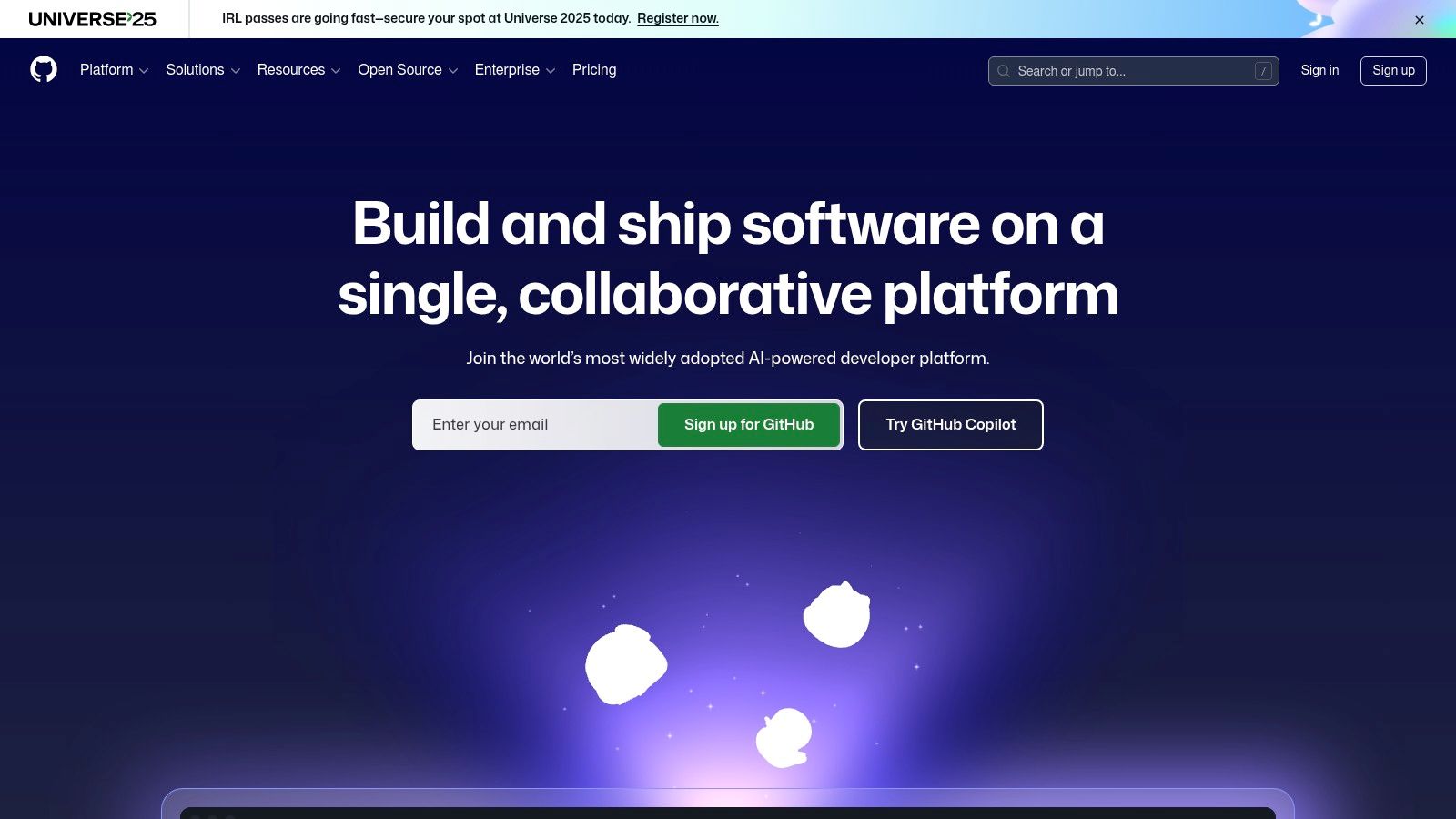
This native feature lets you automate software development workflows directly from your repository. You can build, test, and deploy code on Linux, macOS, and Windows virtual machines. The GitHub Marketplace extends this functionality, offering thousands of pre-built reusable Actions created by the community. This allows you to easily integrate services like cloud providers (AWS, Azure), testing frameworks, and notification tools without writing complex scripts from scratch.
Key Features and Considerations
GitHub’s ecosystem creates a seamless flow from code management to automated execution, making it a unique platform for developers and teams.
- GitHub Actions: Automate workflows triggered by events like code pushes, pull requests, or on a schedule. It supports matrix builds to test your code across multiple operating systems and versions simultaneously.
- Massive Project Discovery: The platform is the primary place to find, fork, and contribute to nearly any open source automation tool available today.
- Marketplace: Easily discover and add third-party apps and Actions to your workflow, significantly reducing development time.
- Pricing Model: Public repositories get a generous free tier, including CI/CD minutes and package storage. Costs for private repositories are based on usage, with higher-tier plans required for advanced security and enterprise governance features.
Website: https://github.com
3. Jenkins
Jenkins is a cornerstone of the open source automation tools landscape, serving as a highly extensible and self-hosted automation server. Primarily known for driving continuous integration and continuous delivery (CI/CD) pipelines, it allows teams to automate building, testing, and deploying software. Its power lies in its unparalleled flexibility, offering complete control over the automation environment from the ground up.
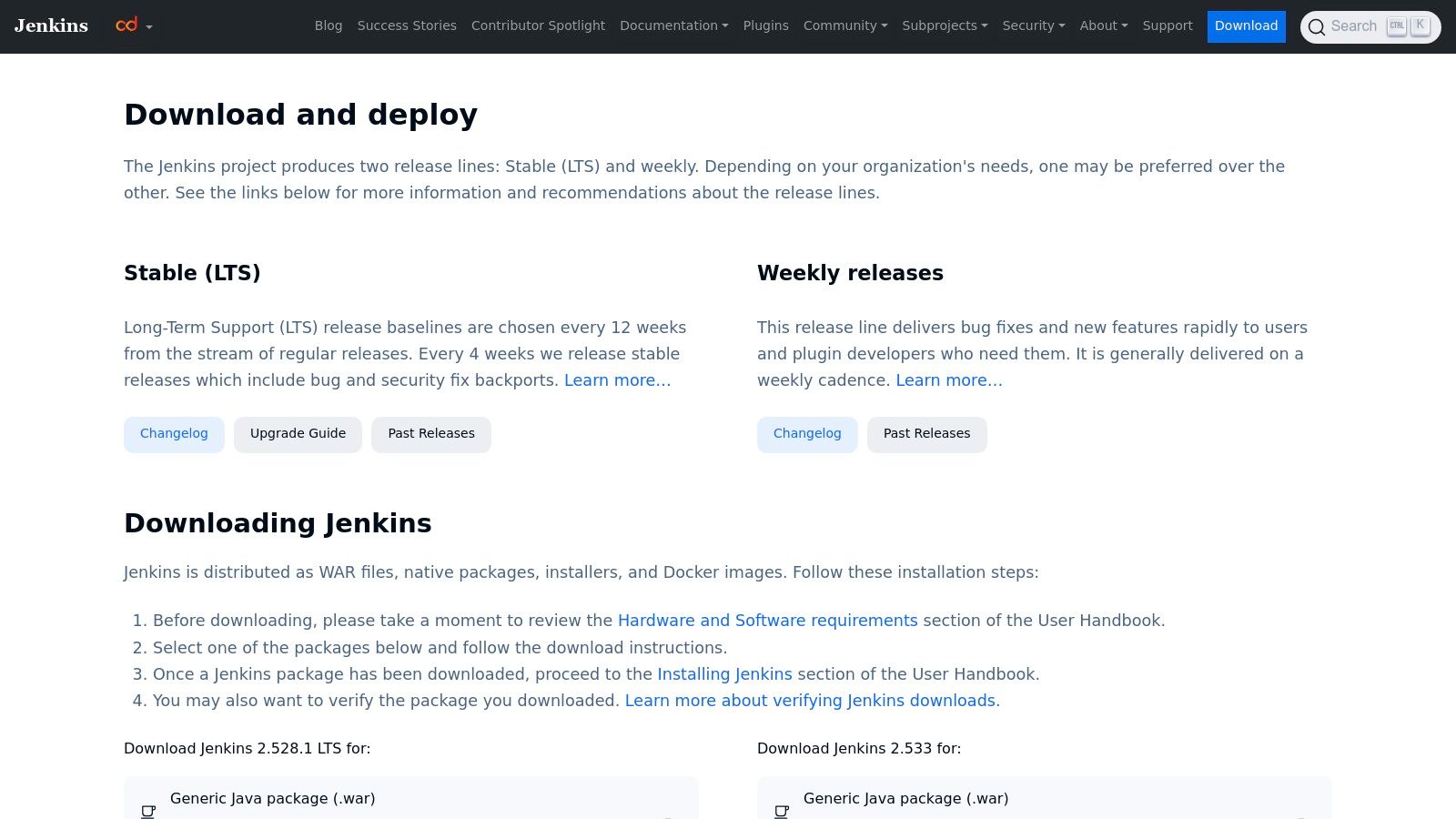
Unlike SaaS platforms, Jenkins is a standalone application that you deploy on your own infrastructure, whether on-premises or in the cloud. This gives you total command over security, resources, and configuration. Its true standout feature is its vast plugin ecosystem, which contains over 1,800 community-contributed plugins. This allows you to integrate Jenkins with virtually any tool in your development and operations toolchain, from version control systems like Git to cloud providers and testing frameworks.
Key Features and Considerations
Jenkins remains a popular choice for organizations that require a highly customizable and powerful automation engine without vendor lock-in.
- Extensive Plugin Ecosystem: Its massive library of plugins is its greatest strength, enabling integration with nearly any software, service, or platform.
- Pipeline as Code: Define your entire CI/CD pipeline in a
Jenkinsfilethat lives alongside your application code, promoting versioning, collaboration, and review. - Distributable Builds: Jenkins can distribute build and test workloads across multiple machines (agents), enabling parallel execution and scaling for large projects.
- Self-Hosted and Free: As a free, open source project, there are no licensing costs. However, you are responsible for the operational overhead of hosting, maintaining, and securing the server and its agents. The user interface can feel dated and requires some effort to manage at scale.
Website: https://www.jenkins.io/download/
4. Apache Airflow
Apache Airflow is a powerful, open-source platform designed to programmatically author, schedule, and monitor workflows. It has become the industry standard for orchestrating complex data pipelines, making it one of the most essential open source automation tools for data engineers, data scientists, and ML teams. Workflows are defined as Directed Acyclic Graphs (DAGs) using standard Python code, offering immense flexibility and control.
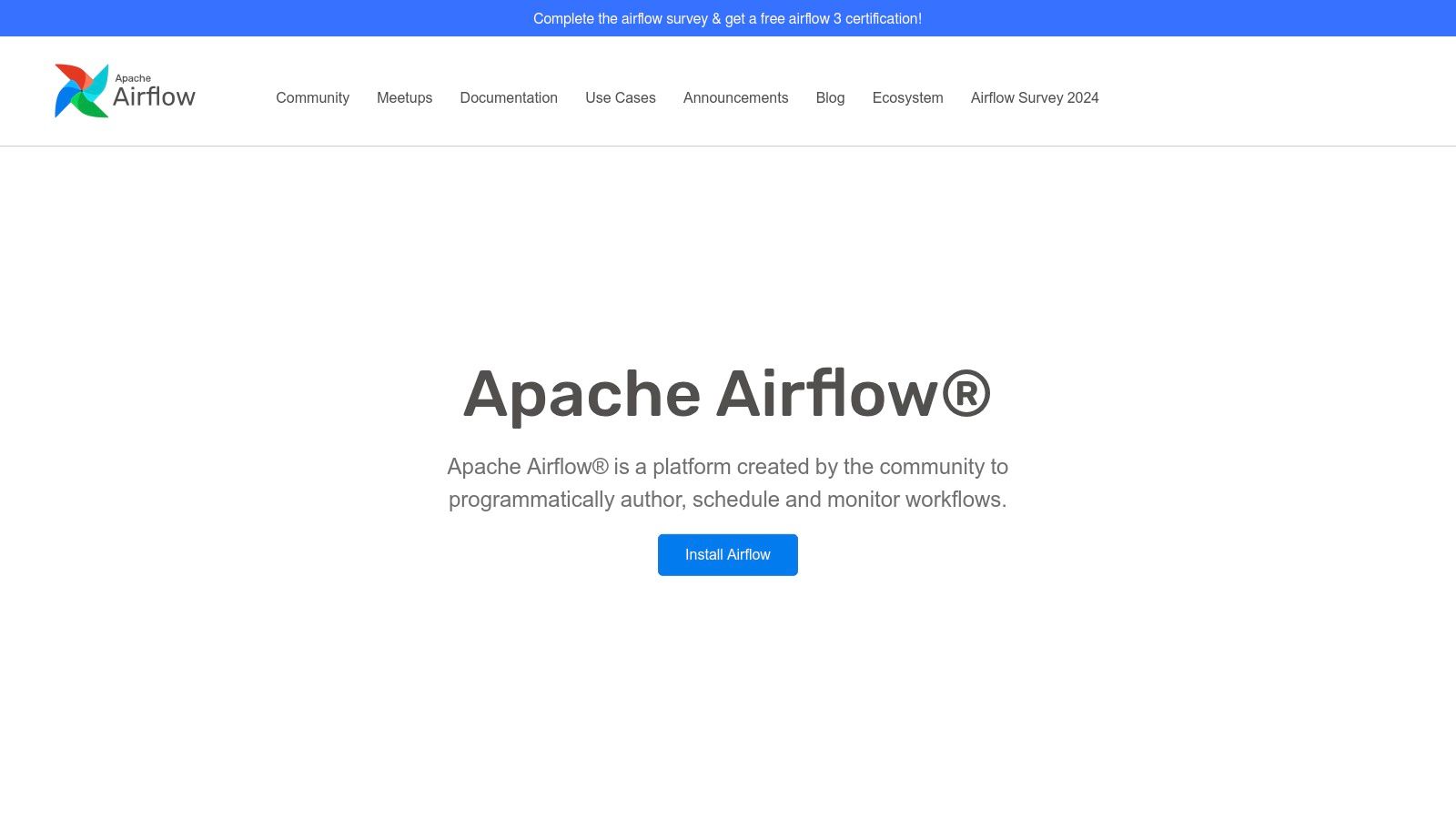
Unlike general-purpose CI/CD tools, Airflow excels at managing intricate data dependencies and long-running tasks. Its rich user interface allows for visualizing pipeline progress, monitoring logs, and manually triggering runs, which is crucial for managing data-centric operations. With multiple installation options, including official Docker images and Helm charts, it can be deployed anywhere from a local machine to a scalable Kubernetes cluster in the cloud.
Key Features and Considerations
Airflow's strength lies in its code-first approach and extensive provider ecosystem, which enables seamless integration with countless third-party services like cloud data warehouses and machine learning platforms.
- Python-Based DAGs: Define all your workflows as code, enabling version control, collaboration, and dynamic pipeline generation.
- Rich Provider Ecosystem: A vast library of pre-built integrations allows you to connect with hundreds of services (AWS, Google Cloud, Snowflake, etc.) out of the box.
- Scalable and Portable: Designed to run distributed tasks across a cluster of workers. Its architecture supports deployment on-premises or on any major cloud provider.
- Operational Complexity: While powerful, Airflow has a steeper learning curve and requires more infrastructure management than simpler, single-node tools. It is best suited for scheduled, batch-oriented workflows rather than real-time event processing.
Website: https://airflow.apache.org
5. Selenium
When it comes to web browser automation, Selenium is the undisputed open-source standard. For years, it has provided the foundational technology for testing web applications, scraping data, and performing any task that requires interacting with a website programmatically. Its core component, Selenium WebDriver, offers a powerful API to control browser actions like clicking buttons, filling forms, and navigating pages.
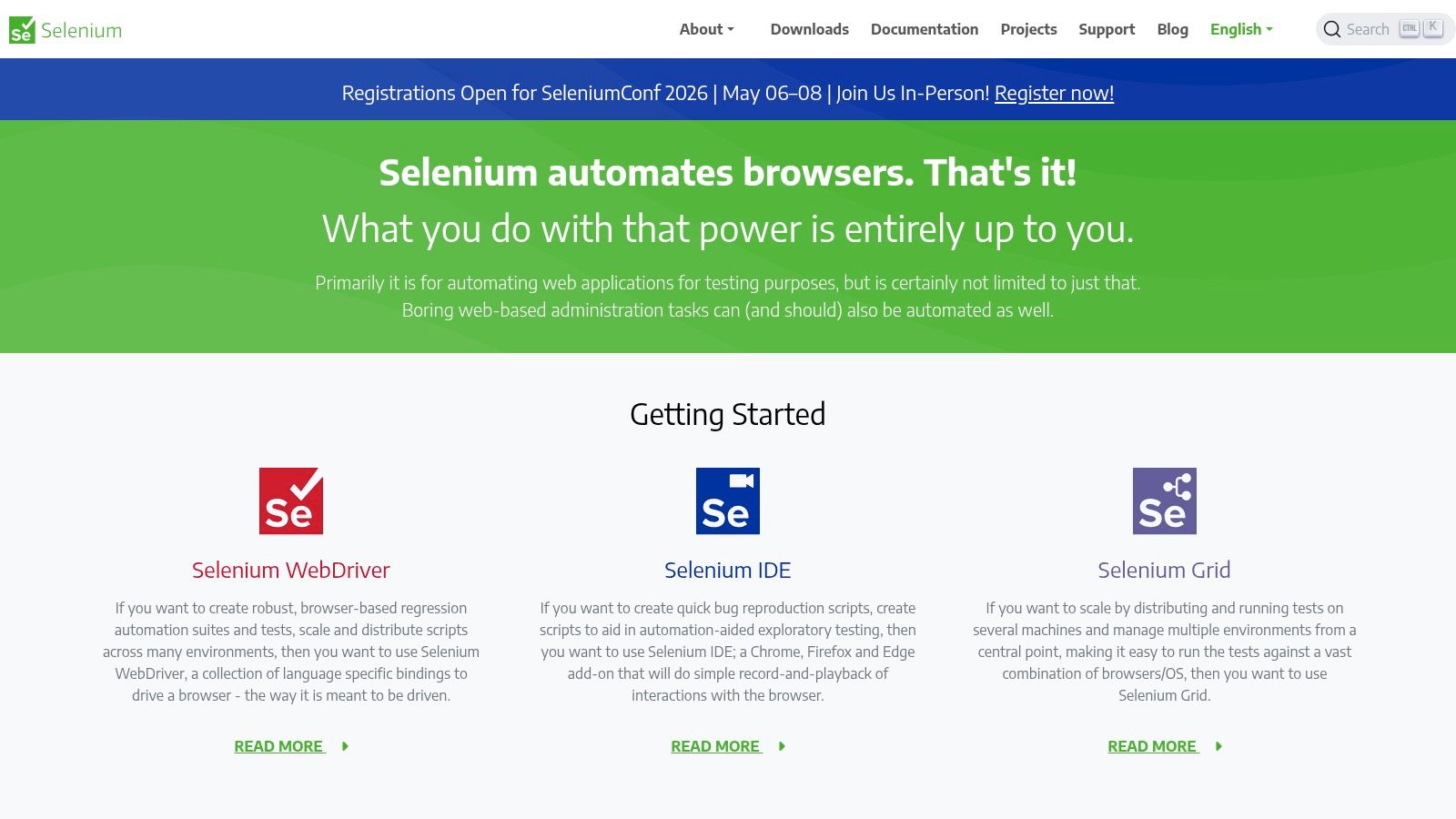
Selenium's strength lies in its cross-platform and cross-language compatibility. You can write your automation scripts in Java, Python, C#, JavaScript, and other popular languages, and then run them against Chrome, Firefox, Safari, and Edge. This flexibility makes it one of the most versatile open source automation tools available. The ecosystem also includes Selenium Grid, which enables parallel test execution across multiple machines, drastically reducing the time it takes to run a large test suite.
Key Features and Considerations
Selenium provides a robust framework that, while requiring technical expertise, offers unparalleled control over browser-based automation tasks.
- WebDriver API: A powerful, language-agnostic interface for controlling web browsers natively. This allows for creating stable and realistic user interaction tests.
- Selenium Grid: Facilitates distributed testing, allowing you to run tests in parallel on different machines and browsers simultaneously to speed up execution.
- Broad Ecosystem: Integrates seamlessly with nearly every major testing framework (like JUnit, TestNG, PyTest) and CI/CD tool (like Jenkins, GitLab CI). Its widespread adoption means extensive community support and resources are available.
- Implementation Overhead: While completely free, setting up and maintaining a scalable Selenium Grid requires significant configuration. Additionally, writing stable tests demands careful handling of waits and selectors to avoid flakiness.
Website: https://www.selenium.dev
6. Robot Framework
Robot Framework is a generic, open source automation framework for acceptance testing, acceptance test-driven development (ATDD), and robotic process automation (RPA). It stands out with its keyword-driven approach, which allows you to create high-level, human-readable tests and automation scripts using a simple, tabular syntax. This design makes it highly accessible to team members who may not have deep programming expertise.
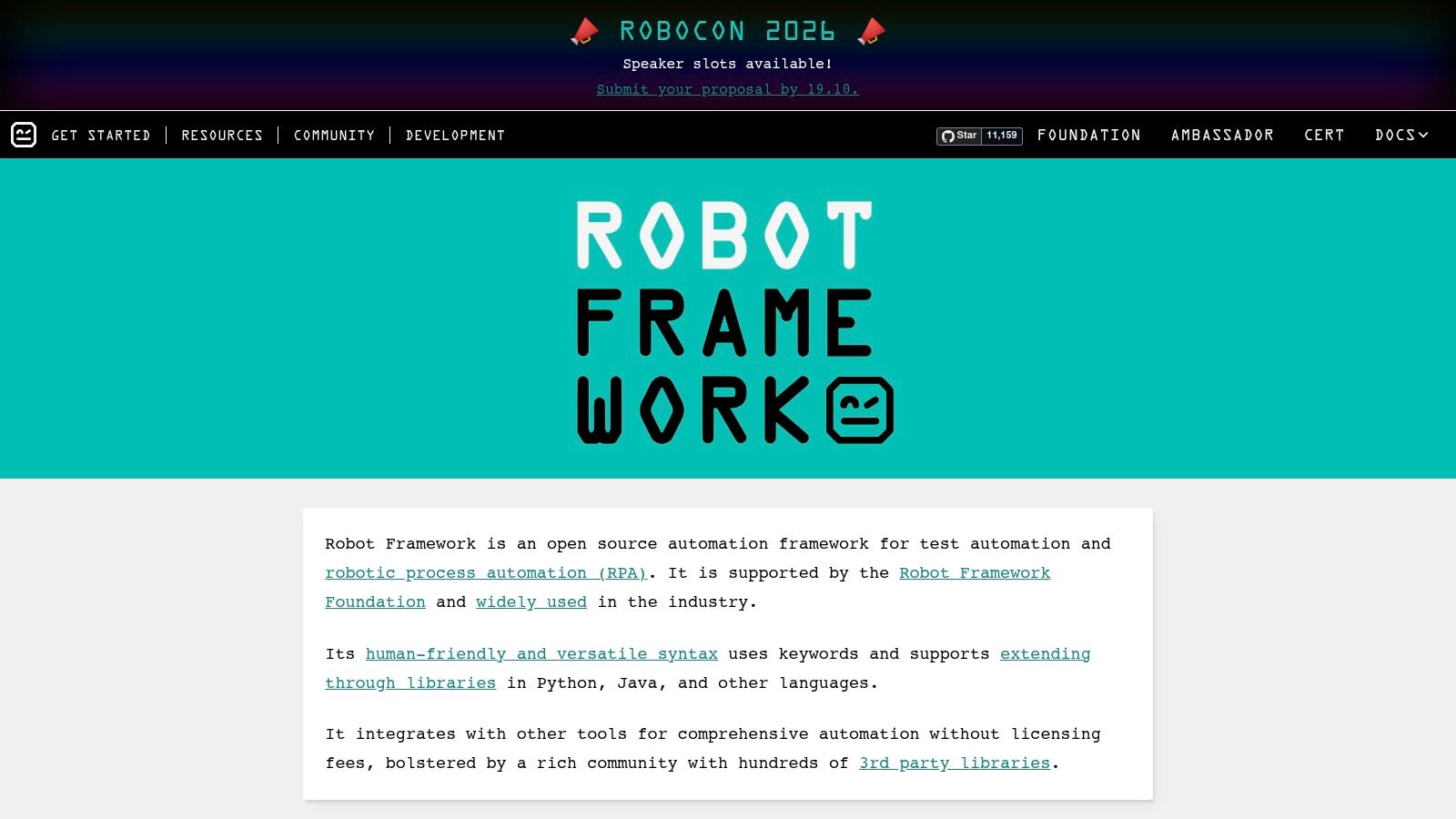
Based on Python, its real power lies in its massive and extensible ecosystem of libraries. You can easily import libraries for web testing (like SeleniumLibrary), API automation, database connections, and more. This makes Robot Framework one of the most versatile open source automation tools, capable of handling complex end-to-end scenarios across different technologies and platforms with a unified, easy-to-understand syntax.
Key Features and Considerations
The framework’s focus on readability and extensibility makes it a strong choice for teams that prioritize clear test cases and broad integration capabilities.
- Keyword-Driven Syntax: Test cases are written using keywords in a simple, tabular format. This approach makes tests easy to write, read, and maintain, even for non-developers.
- Extensive Library Ecosystem: It offers a rich set of standard libraries and a vast collection of community-created external libraries for everything from web and mobile to desktop and API automation.
- Cross-Platform and Technology-Agnostic: Being Python-based, it runs on Windows, macOS, and Linux. Its architecture allows it to test applications written in any language.
- Limitations: While excellent for high-level tests, complex logic or performance-intensive operations may require creating custom keywords in Python. It can also require additional tooling for seamless integration in some modern CI/CD pipelines.
Website: https://robotframework.org
7. Node-RED
Node-RED provides a browser-based, flow-oriented programming approach to automation, making it one of the most accessible open source automation tools for developers and makers alike. It excels at wiring together hardware devices, APIs, and online services in novel ways. The visual editor allows you to connect pre-built "nodes" to create complex workflows, or "flows," without writing extensive code.
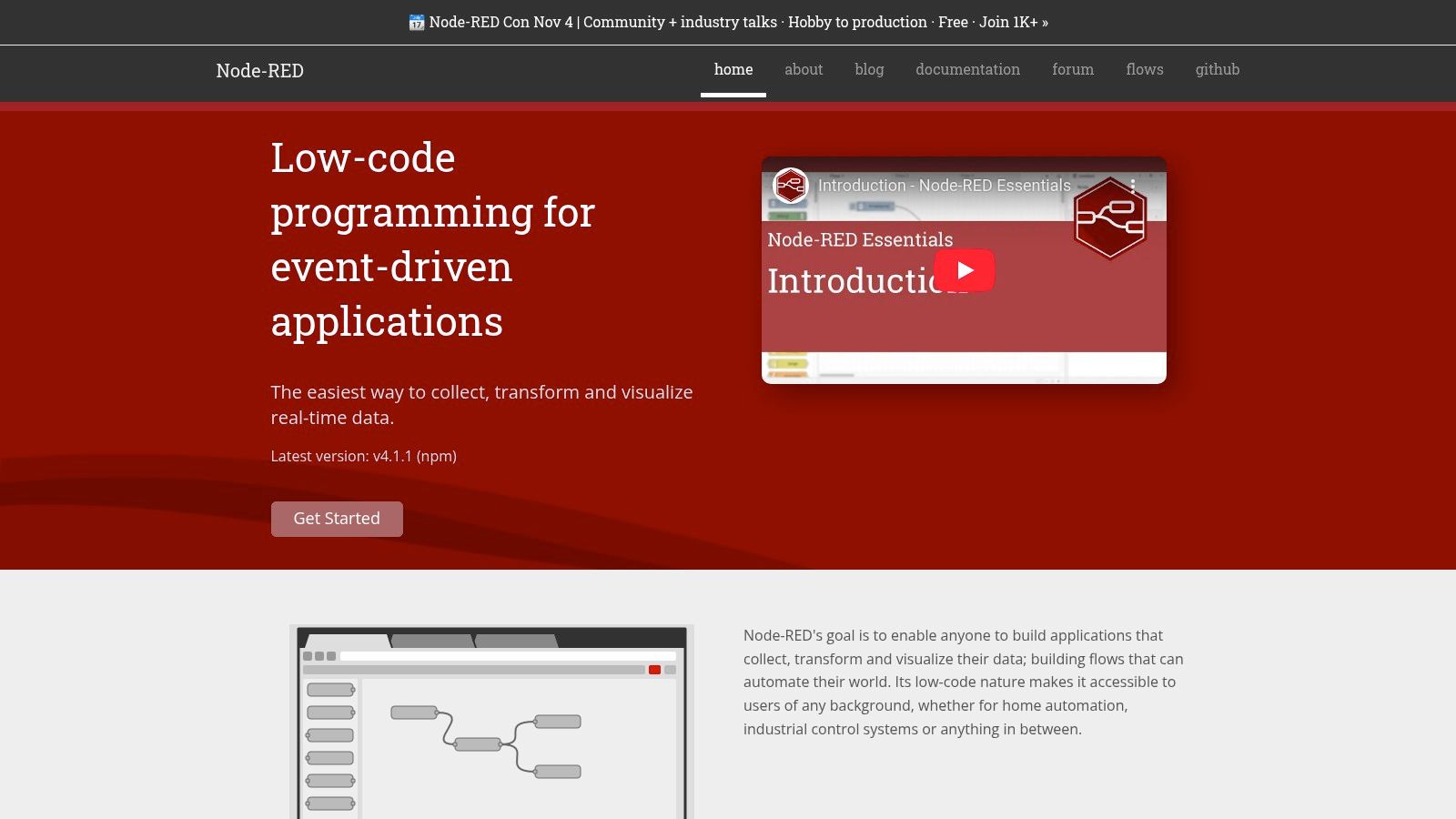
This tool is especially popular in the IoT and home automation communities, as its lightweight runtime can operate on low-cost hardware like a Raspberry Pi. However, its versatility extends to data processing, API mocking, and even building simple backends for web applications. The single-click deployment from the editor to the runtime makes prototyping incredibly fast, and with a massive library of community-contributed nodes, you can integrate almost any service imaginable. This ease of use makes it a great entry point for those looking to automate tasks visually; for example, you can learn more about how to automate social media posts using similar principles.
Key Features and Considerations
Node-RED lowers the barrier to entry for creating powerful, event-driven applications, but managing large-scale projects requires a disciplined approach.
- Visual Flow-Based Editor: Drag and drop nodes from a palette and wire them together to create your automation logic. The browser-based interface makes it easy to manage from any device.
- Lightweight and Versatile: Runs efficiently on low-power devices, in the cloud, or on a local machine, giving you complete deployment flexibility.
- Extensive Node Library: Access over 5,000 community-developed nodes that provide instant integration with databases, APIs, messaging protocols (like MQTT), and popular web services.
- Project Governance: While excellent for rapid prototyping, complex flows can become difficult to manage. Larger projects require careful organization and versioning discipline to remain maintainable.
Website: https://nodered.org
8. n8n
n8n is a powerful, node-based workflow automation tool designed as an open source alternative to platforms like Zapier. It empowers users to connect different applications and services through a visual, drag-and-drop interface, making complex automations accessible without deep coding knowledge. Its "fair-code" license allows you to self-host the Community Edition for free, giving you complete control over your data and infrastructure.
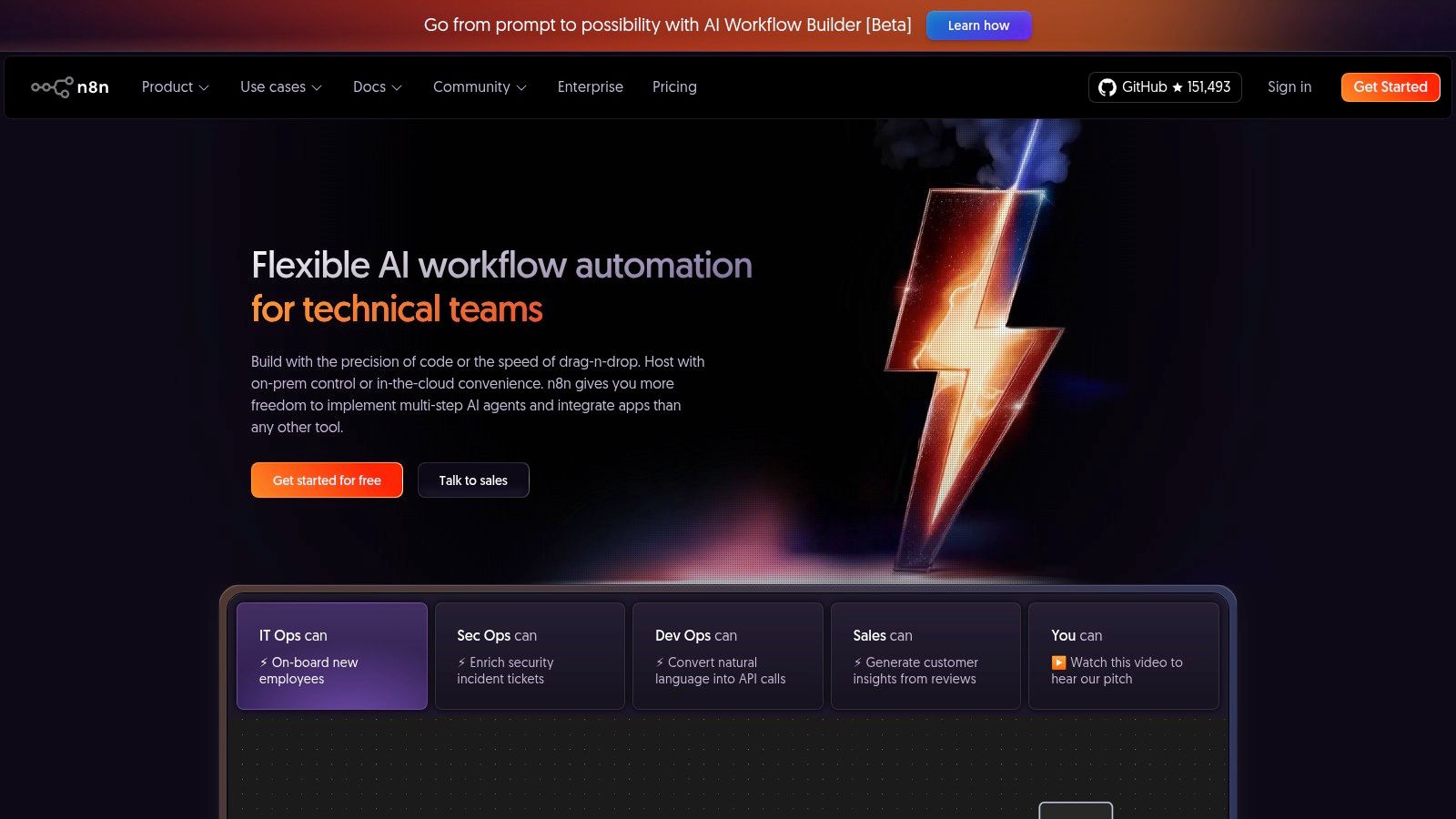
This platform excels at creating multi-step workflows that can manipulate data, trigger actions in other apps, and build sophisticated pipelines. It supports over 350 built-in integrations, from CRMs and marketing platforms to databases and custom APIs. For those who prefer a managed solution, n8n also offers a cloud version with usage-based pricing, providing flexibility for businesses of all sizes. Learn more about how to integrate social media scheduling with n8n.
Key Features and Considerations
n8n’s strength lies in its flexibility, offering both a simple visual builder and the ability to extend functionality with custom code for advanced use cases.
- Visual Workflow Editor: Build, visualize, and debug complex automations using a clear, node-based canvas that shows how data flows between applications.
- Flexible Hosting: Choose between the free, self-hosted Community Edition for maximum control or the convenient, managed cloud platform.
- Extensive Integrations: A large and growing library of pre-built nodes for popular SaaS applications, databases, and APIs.
- Pricing Model: The self-hosted version is free. The cloud version uses a usage-based model billed in EUR, so it’s important to monitor workflow executions to manage costs effectively.
Website: https://n8n.io
9. Salt Project
Salt Project is a powerful open-source automation tool designed for event-driven orchestration and configuration management at a massive scale. It excels in managing large, complex infrastructures, offering high-speed data transport and remote execution capabilities that allow system administrators to run commands on thousands of servers in seconds. Its unique architecture is built around a dynamic communication bus, making it ideal for creating reactive, self-healing systems.

Unlike other configuration management tools, Salt’s event-driven model allows it to respond to changes across the environment in real time. This makes it a standout choice for complex automation scenarios, such as auto-scaling infrastructure, triggering remediation actions, or orchestrating multi-stage deployments. The platform uses a master-minion topology and defines system states declaratively, ensuring servers are always in their intended configuration.
Key Features and Considerations
Salt Project is an excellent choice for organizations that need highly scalable and responsive infrastructure automation.
- Remote Execution: Execute commands and scripts across thousands of nodes simultaneously with incredible speed, making it perfect for fleet-wide updates or data collection.
- Configuration Management: Define system states using YAML to ensure consistent server configuration. Its state system is both powerful and idempotent.
- Event-Driven Orchestration: Leverage a powerful event bus to build complex, reactive automation workflows that respond to system events in real time.
- Learning Curve: The concepts of states, pillars, and the eventing system can be complex for newcomers. Mastering its advanced features requires operational expertise and a solid understanding of its core components.
Website: https://saltproject.io
10. StackStorm
Often described as "IFTTT for Ops," StackStorm is an open source, event-driven automation platform designed to connect disparate services and automate complex operational workflows. Its core strength lies in its ability to listen for events from various tools (like monitoring systems, CI/CD pipelines, or chat clients) and trigger automated responses, a process known as auto-remediation. This makes it a powerful choice for Site Reliability Engineering (SRE) and DevOps teams looking to automate incident response.
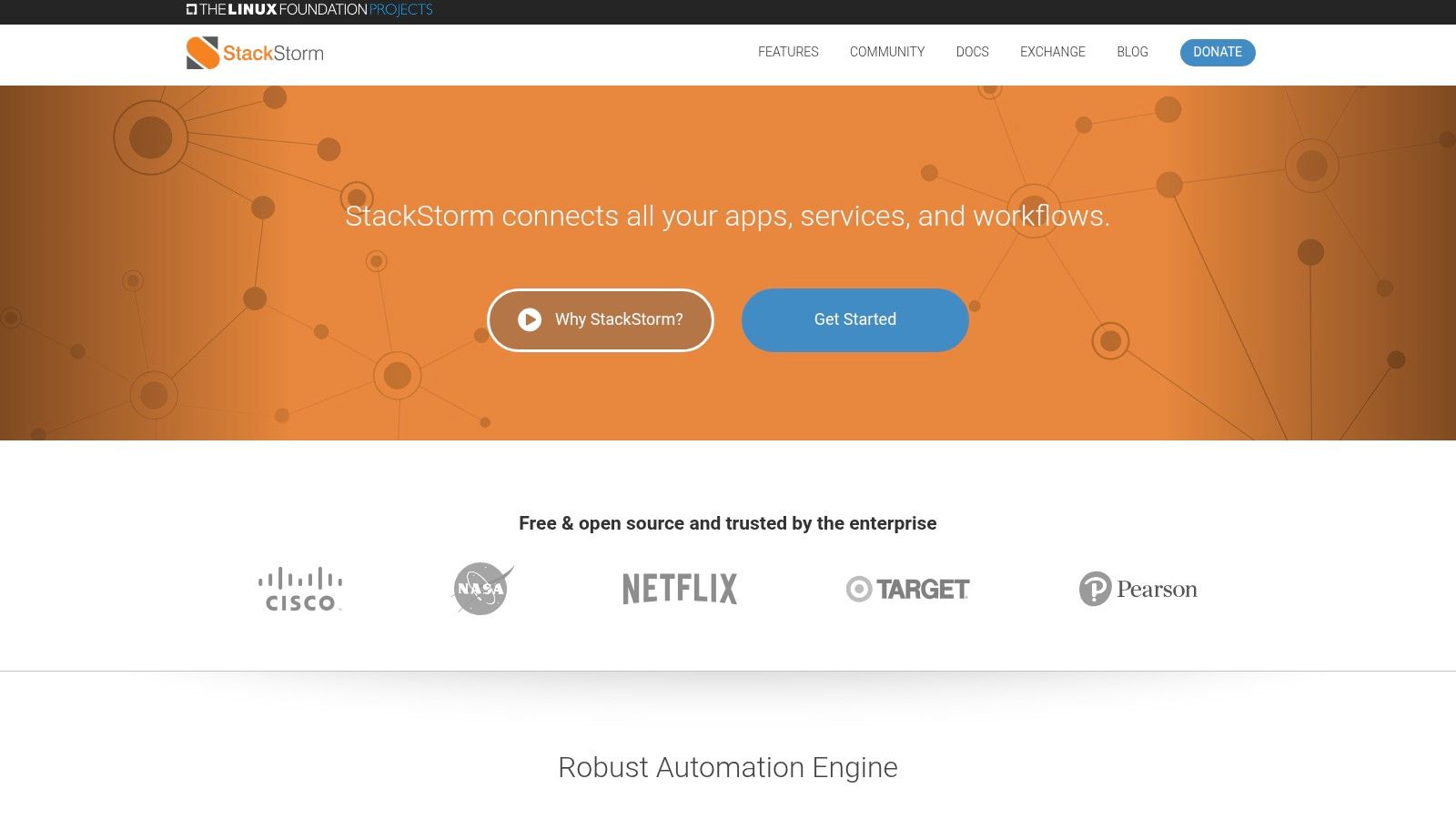
The platform is built around a flexible rules engine that maps triggers to actions or complex workflows. With the StackStorm Exchange, users gain access to a vast ecosystem of over 160 integration packs, enabling connections to tools like AWS, Kubernetes, Jira, and Slack out of the box. This extensibility allows teams to create sophisticated runbooks for tasks ranging from restarting a failed service to provisioning cloud infrastructure directly from a ChatOps command.
Key Features and Considerations
StackStorm excels at creating cross-domain workflows that tie together all the tools in your tech stack, making it one of the most versatile open source automation tools for infrastructure management.
- Event-Driven Architecture: Utilizes sensors to detect events (triggers) and a rules engine to execute actions or multi-step Orquesta workflows in response.
- Extensive Integration Packs: The StackStorm Exchange provides thousands of pre-built actions and sensors, dramatically accelerating the automation of common operational tasks.
- ChatOps and Auto-Remediation: A primary use case is building bots that can execute remediation tasks based on alerts, or respond to commands issued by engineers in chat.
- Operational Complexity: As a comprehensive platform, it requires more initial setup and maintenance compared to simpler, single-purpose tools. It is typically deployed via Docker or Kubernetes.
Website: https://stackstorm.com
11. Home Assistant (including Home Assistant Green)
While many automation tools focus on software and IT, Home Assistant brings open source automation into the physical world. It is a powerful, privacy-focused home automation platform that puts you in control of all your smart devices. Its core philosophy is local control, ensuring your data stays within your home network and your automations run even if the internet goes down.
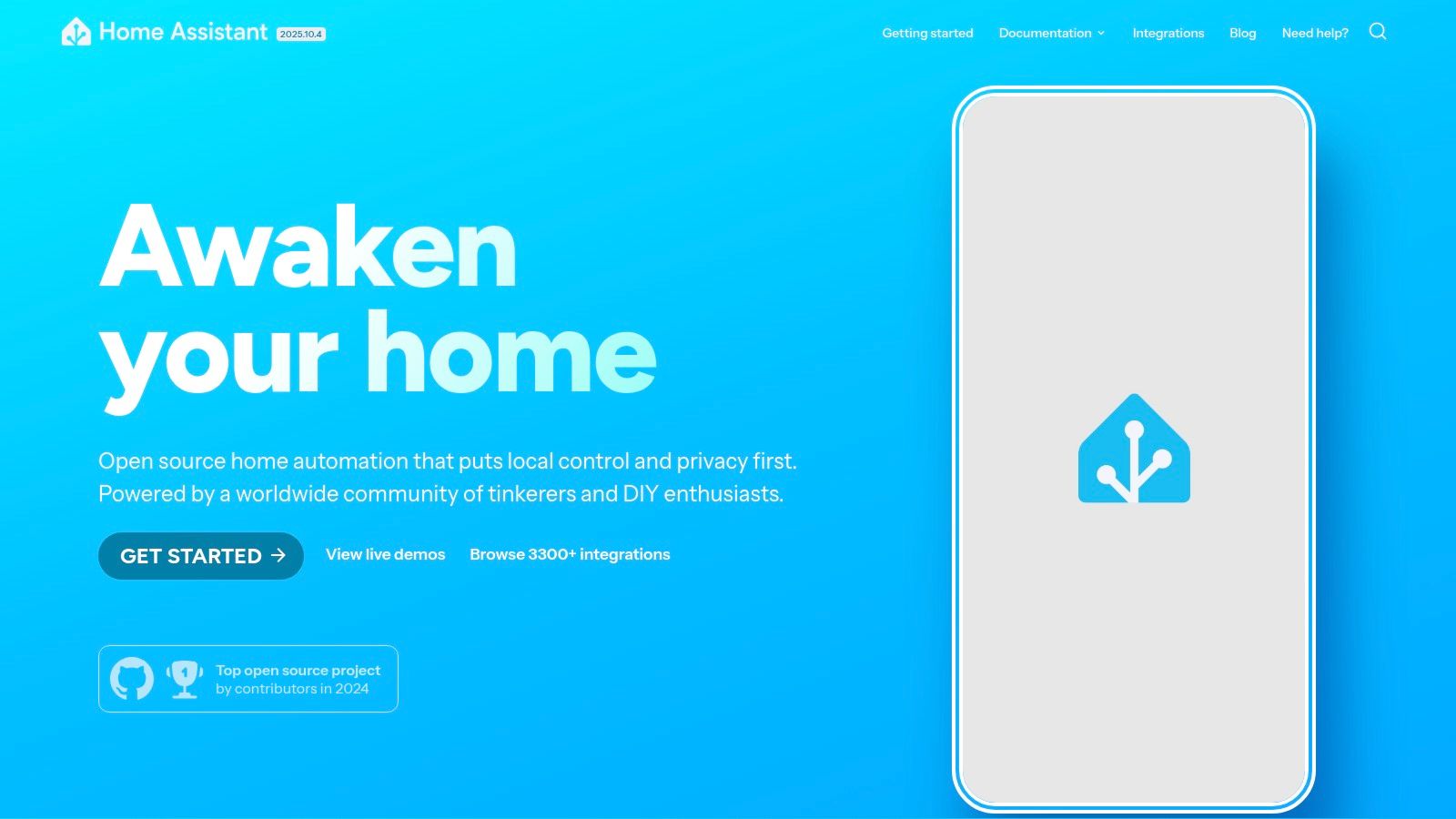
With over a thousand integrations and monthly software updates, Home Assistant can unify devices from countless different brands into a single, cohesive system. For those seeking a simpler entry point, the official Home Assistant Green hardware provides a pre-loaded, plug-and-play hub. This turnkey option removes the initial setup complexities of installing the software on your own hardware, making it one of the most accessible open source automation tools for smart home enthusiasts and privacy-conscious users.
Key Features and Considerations
Home Assistant empowers users to create sophisticated routines, from lighting and climate control to advanced security and energy management, all without relying on cloud services.
- 1,000+ Integrations: Connect and automate a vast ecosystem of smart devices, platforms, and online services, from smart bulbs to weather APIs.
- Local-First Architecture: Emphasizes privacy and reliability by processing automations on your local network, reducing latency and dependency on third-party servers.
- Home Assistant Green: An official, affordable hardware option (quad-core ARM, 4 GB RAM) that offers a simplified, plug-and-play setup for new users.
- Hardware Extensibility: The platform is highly customizable, but advanced setups for protocols like Z-Wave, Zigbee, or Thread may require purchasing separate USB dongles or radios.
Website: https://www.home-assistant.io
12. openHAB
Focused on smart home automation, openHAB is a powerful, vendor-agnostic platform that puts local control and privacy first. It acts as a central hub, integrating disparate smart devices from over 400 different technologies into one cohesive system. This makes it one of the most versatile open source automation tools for creating a truly unified smart home experience without being locked into a single company’s ecosystem.
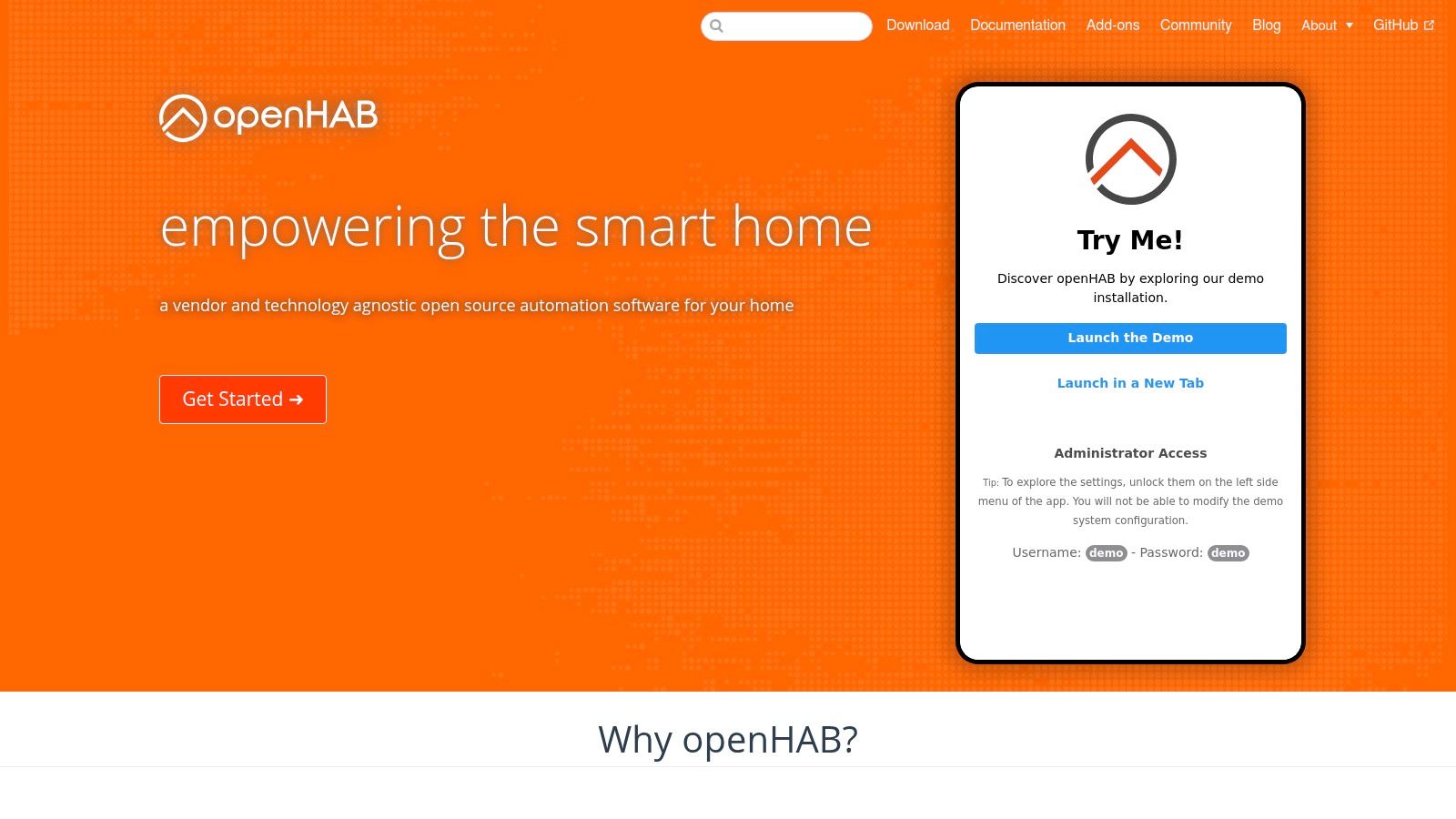
The platform runs on-premise on devices like a Raspberry Pi, Linux server, or even a Docker container, ensuring your data stays within your network. Its strength lies in its extensive library of "bindings" (add-ons) that connect to everything from smart lights and thermostats to weather services and AV equipment. You can then create complex automation rules using graphical tools or scripting languages like JavaScript and Python to make your home react intelligently to your needs.
Key Features and Considerations
openHAB is ideal for developers and tech-savvy users who want complete control over their smart home environment, free from cloud-dependency and vendor limitations.
- Vendor-Agnostic Integration: Its primary strength is the massive Add-on Store, which provides bindings to connect hundreds of different brands and protocols.
- Powerful Automation Engine: Create simple or highly complex automation rules using a block-based editor, JavaScript, Python, or other scripting languages.
- Local Processing: All automation logic runs locally, ensuring high reliability and privacy. It does not depend on an internet connection to function.
- Configuration Curve: While powerful, the initial setup and configuration can be complex for beginners. It requires a more hands-on approach compared to commercial turnkey solutions.
Website: https://www.openhab.org
Top 12 Open Source Automation Tools — Feature Comparison
| Product | ✨ Core features | ★ UX / Quality | 💰 Price / Value | 👥 Target audience | 🏆 Unique selling points |
|---|---|---|---|---|---|
| 🏆 Postiz | Scheduling & cross-posting, AI content + image gen, Canva-like editor, automations | ★★★★★ Easy UX; consolidated analytics | 💰 7‑day trial; contact for plans; self‑host option | 👥 Creators, agencies, privacy‑first teams | 🏆 ✨ Open‑source + self‑hosting; AI assistants; auto‑post/like/comment; unified workflow |
| GitHub (Actions & Marketplace) | Repo hosting, Actions CI/CD, Marketplace of Actions/apps | ★★★★ Massive OSS ecosystem; smooth code→automation | 💰 Free for public; paid private minutes & org tiers | 👥 Developers, OSS maintainers, automation builders | ✨ Huge Action marketplace; seamless code-integrated automation |
| Jenkins | CI/CD server, extensible plugin ecosystem, multiple packaging options | ★★★ Mature & flexible but ops‑heavy | 💰 Free (self‑host) — infra & maintenance costs | 👥 DevOps teams, enterprises | ✨ Extremely extensible plugins; customizable pipelines |
| Apache Airflow | DAG authoring, scheduling, monitoring, provider SDK & Helm charts | ★★★ Industry‑standard for data workflows (operationally heavy) | 💰 Free (open‑source) — infra cost for scale | 👥 Data engineers, ML teams | ✨ Portable DAGs; rich provider ecosystem; k8s/cloud friendly |
| Selenium | WebDriver APIs, Grid for parallel runs, IDE for record/playback | ★★★ Broad language/cloud support; can be flaky | 💰 Free (open‑source) — infra for Grid | 👥 QA engineers, test automation teams | ✨ Cross‑browser automation; broad ecosystem & cloud integrations |
| Robot Framework | Keyword-driven tests, large libraries, readable high-level syntax | ★★★★ Human‑readable; easy to onboard non‑devs | 💰 Free (open‑source) | 👥 QA teams, RPA users, testers | ✨ Keyword syntax; extensible libraries for many platforms |
| Node-RED | Browser flow editor, 5,000+ community nodes, single‑click deploy | ★★★★ Fast prototyping; lightweight runtime | 💰 Free (self‑host) — optional cloud infra | 👥 IoT hobbyists, integrators, edge developers | ✨ Low‑code visual flows; huge node palette for integrations |
| n8n | Visual workflow builder, 365+ integrations, cloud & self‑host | ★★★★ Intuitive visual automation; versioning | 💰 Free self‑host; cloud execution‑based billing (EUR) | 👥 Ops, SaaS integrators, marketers | ✨ Self‑hostable + managed cloud; many built‑in connectors |
| Salt Project | Remote execution, config management, event bus & orchestration | ★★★ Scales well but steeper learning curve | 💰 Free (open‑source) — infra & ops cost | 👥 Sysadmins, infra & operations teams | ✨ Scales to thousands of nodes; powerful event‑driven automation |
| StackStorm | Event‑driven workflows (Orquesta), sensors/triggers, packs | ★★★ Good for Ops auto‑remediation; setup required | 💰 Free (open‑source) — deploy costs | 👥 SRE/DevOps, ChatOps teams | ✨ Packs exchange; strong auto‑remediation & ChatOps focus |
| Home Assistant | 1,000+ integrations, local‑first architecture, Home Assistant Green | ★★★★ Privacy‑centric; active community | 💰 Free software; optional Green hardware purchase | 👥 Home users, privacy‑focused smart homes | ✨ Local‑first privacy; turnkey Green hub for easy setup |
| openHAB | Add‑on store, multi‑language scripting, myopenHAB remote access | ★★★ Modular & vendor‑agnostic; steeper initial setup | 💰 Free (open‑source) — optional services/devices | 👥 Power users, DIY home automation | ✨ Vendor‑agnostic bindings; secure remote access via myopenHAB |
Final Thoughts
Navigating the expansive world of open source automation tools can feel overwhelming, but as we've explored, this landscape is rich with powerful, flexible, and cost-effective solutions. From automating your social media with Postiz to orchestrating complex CI/CD pipelines with Jenkins and managing your smart home with Home Assistant, the possibilities are virtually limitless. The core takeaway is that you don't need a massive budget or a proprietary software suite to achieve sophisticated automation.
The true strength of these tools lies not just in their code, but in their communities. When you adopt a tool like GitHub Actions, Apache Airflow, or Selenium, you gain access to a global network of developers, users, and contributors. This collective brainpower drives constant innovation, provides extensive documentation, and offers a support system that can be more responsive and insightful than any corporate helpdesk.
Key Takeaways from Our Deep Dive
Reflecting on the dozen tools we've analyzed, a few central themes emerge. First, specialization matters. A tool like Salt Project is purpose-built for IT infrastructure management and excels there, while n8n shines in workflow automation that connects disparate APIs. Trying to force one tool to do a job it wasn't designed for will only lead to frustration.
Second, the learning curve varies dramatically. Tools like Node-RED and n8n offer visual, low-code interfaces that make automation accessible to a broader audience. In contrast, mastering Jenkins, StackStorm, or Apache Airflow requires a deeper understanding of scripting, configuration files, and underlying development principles. Be realistic about your team's technical skills when making a choice.
Finally, "open source" is not a synonym for "no effort." While you save on licensing fees, you invest in implementation time, configuration, and ongoing maintenance. This trade-off grants you unparalleled control and customization, a crucial advantage for businesses and developers who need solutions tailored precisely to their unique processes.
How to Choose the Right Automation Tool for You
Selecting the perfect tool from this list of powerful open source automation tools comes down to a clear-eyed assessment of your specific needs. Don't just pick the most popular option; instead, ask yourself these critical questions:
- What is my primary goal? Are you trying to automate software testing (Selenium, Robot Framework), manage server configurations (Salt Project), streamline business workflows (n8n, Node-RED), or build a robust CI/CD pipeline (Jenkins, GitHub Actions)? Define your core problem first.
- What is my team's technical skill set? Can your team comfortably work with YAML files, Python scripts, or command-line interfaces? Or would a visual, node-based editor be more effective? Choose a tool that aligns with your existing capabilities to ensure successful adoption.
- How important is the ecosystem? Do you need a vast library of pre-built integrations and plugins? Tools like Jenkins, Home Assistant, and GitHub Actions have massive marketplaces and communities, offering ready-made solutions for countless scenarios.
- What are my scalability requirements? Consider your future needs. Will a simple workflow tool suffice, or do you need an enterprise-grade orchestrator like Apache Airflow that can handle massive data pipelines and complex dependencies?
By carefully considering these factors, you can move from a long list of possibilities to a short list of viable candidates. The best approach is often to start small. Pick a single, high-impact process to automate, implement your chosen tool, and learn from the experience. This iterative approach allows you to build momentum and demonstrate value quickly, paving the way for more ambitious automation projects down the line. The journey into automation is a marathon, not a sprint, and the right open source tools are the perfect companions for the road ahead.
Ready to take control of your social media automation with a powerful, user-friendly open source platform? Postiz offers the scheduling, analytics, and content management features you need, all built on a foundation of transparency and community. Get started with Postiz today and discover how simple and effective open source social media management can be.

